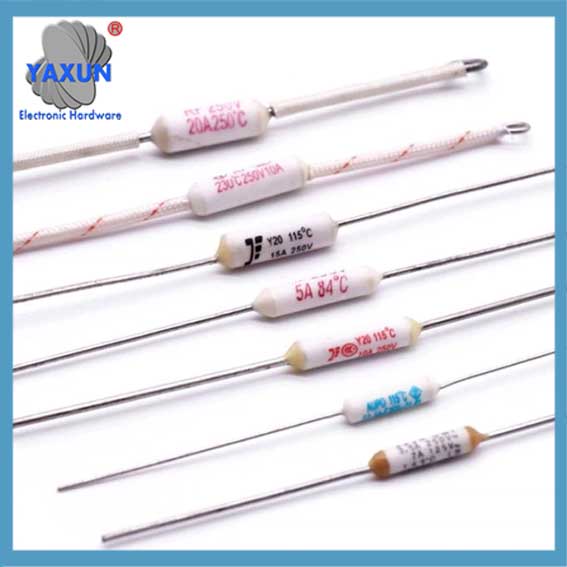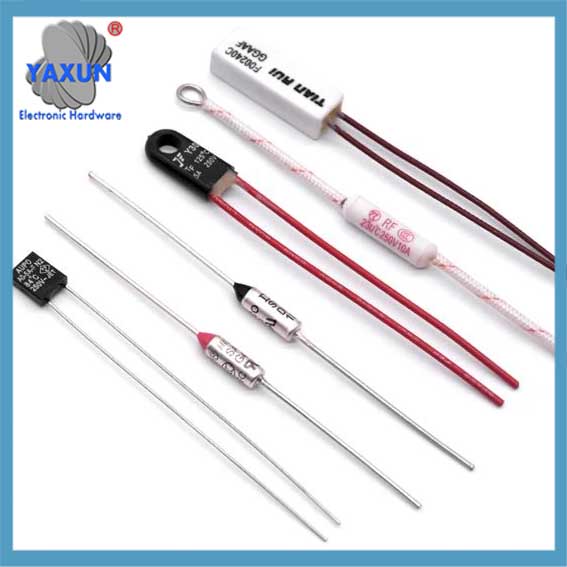製品カテゴリ
- サーマルサーキットブレーカー 20
- ヒューズボックスホルダー 36
- 温度センサー 67
- サーマルスイッチ 64
- カーヒューズ 19
- ボルトダウンヒューズ 7
- 温度ヒューズ 32
- 表面実装ヒューズ 12
- サーミスター 22
- PCB マウント ヒューズ ホルダー 27
- ワイヤハーネス 6
- ブレードヒューズホルダー 17
- サーモスタット 46
- 電気ヒューズ 14
製品タグ
温度ヒューズは、電気機械装置を過熱から保護するために使用される非常に一般的な電子部品です。. 過熱保護装置とも呼ばれます, 過熱保護, および温度保護. 温度ヒューズは電気機械装置の加熱部分の近くに配置され、装置の電源回路または制御回路に直列に接続されます。. 何らかの原因で機器の温度が温度ヒューズの定格値まで上昇した場合, 温度ヒューズは自動的に溶断して機器の電源回路を遮断し、過熱による機器の損傷を防ぎ、電気機械機器を保護します。.
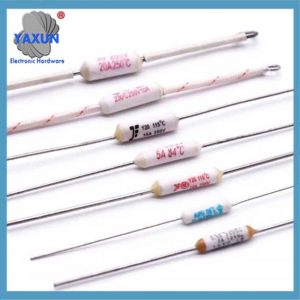 ヘアドライヤー用温度ヒューズ, 電気アイロン, 炊飯器, 電気ストーブ, 変成器, モーター |
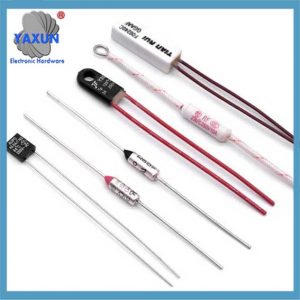 ヘアアイロンの過熱保護用温度ヒューズ |
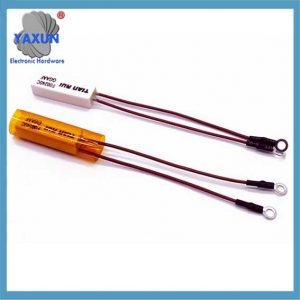 Arlin F00240C 10A 240C 温度ヒューズ GHD ストレイテナー用 |
名前が示すように, 温度ヒューズは、電気機械または電気機器の温度が動作温度まで上昇すると、機器に近い温度ヒューズの内部の温度に敏感な材料を変形させます。 (この値は温度ヒューズのメーカーが製造時に指定します。), それにより電源回路が切断されます.
1. マーキング: メーカーの商標, 定格電圧と定格電流は、240C 温度ヒューズのシェルに明確にマークされている必要があります。.
2. 温度特性: テスト中, 回路のオンとオフを表示するには、電流が10mA未満のインジケータが使用されます。.
3. 定格使用温度 (TF): サンプルをサーモスタットに置きます, TF-20℃に保ちます 2 時間, 0.5~1Kの速度で溶解温度まで加熱します。. 溶解温度は偏差範囲内である必要があります.
4. 温度を保つ (TC): サンプルをサーモスタットに置きます, 定格電圧を超えない電圧を印加してください, 負荷電流10A. TC-6℃に置きます。 168 時間. テスト後, サンプルが溶けたり損傷したりしてはいけません.
5. 湿熱試験: サンプルを38~42℃の温度に置きます。, 相対湿度 90%-95%, そしてテストサイクルは 48 時間. テスト後, 記事を実行する 3, 要件を満たすはずのもの.
6. コールドショックとホットショック: サンプルを-18℃の低温箱に入れます, それを保管してください 15 分, 取り出して室内に置いてください。 5 分, TF-20℃のサーモスタットに入れて、 15 分, 取り出して室内に置いてください。 5 分. 後 3 テストのサイクル, 記事を実行する 3 テスト, 条項の要件を満たす必要がある 8 そして 9.
7. 内部抵抗: 2 本のリード線間で測定 15 シェルを含む分, サンプルの内部抵抗は 5mΩ 未満である必要があります.
8. 絶縁抵抗: サンプルの融合後, 500Vメガオーム計で測定した2本のリード線間の絶縁抵抗は0.2MΩ以上である必要があります。.
9. 電気的強度: 4回目のテストが終わってから, 500V AC 電圧が 2 本のリード間に印加されます。 1 分, 点滅や故障は起こらないはずです.
10. 張力: サンプルを固定し、リード線に軸方向に5Kgの張力を加えます。. 10秒以降, 引っ張ったり緩めたりしてはいけません.
11. 曲げ: サンプルを固定し、シェルから 6mm 離れたところに力を加えます。. まずリード線を曲げます 45 度戻して初期位置に戻します. 破損や亀裂があってはなりません. (リードの一端のみをテストできます)
12. 外観: シェルは滑らかでなければなりません, 亀裂や機械的損傷がないこと; リードは明るいはずです, シェルとの接続はしっかりしており、緩んではいけません。; エポキシ分岐パッケージは滑らかでなければなりません, 流れのない, そしてリードは枝にぶら下がってはいけません.
お問い合わせ
メールを待っています, 以内に返信させていただきます 12 必要な貴重な情報を何時間も入手できる.
 English
English العربية
العربية Български
Български 粤语
粤语 中文(简体)
中文(简体) 中文(漢字)
中文(漢字) Nederlands
Nederlands Suomi
Suomi Français
Français Deutsch
Deutsch Ελληνικά
Ελληνικά Magyar
Magyar Italiano
Italiano 日本語
日本語 한국어
한국어 Polski
Polski Português
Português Română
Română Русский
Русский Slovenščina
Slovenščina Español
Español Svenska
Svenska ภาษาไทย
ภาษาไทย Türkçe
Türkçe Tiếng Việt
Tiếng Việt
